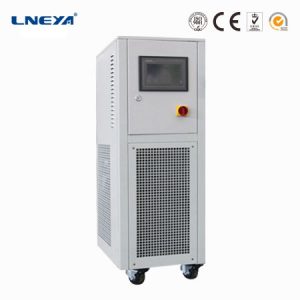The ethylene glycol chiller solution is too cold and too hot
When the ethylene glycol chiller solution
is overheated and overcooled during operation, if you don’t understand these
conditions well, you will not be able to operate the equipment well.

The supercooling phenomenon of the solution
of the glycol chiller refers to the condensed saturated liquid is re-cooled by
a certain device and method, so that the temperature is lower than the
saturation temperature under the condensing pressure. -The occurrence of
subcooling can reduce the flash gas generated by the refrigerant liquid in the
throttling process, reduce the specific volume of the flash gas, increase the
unit refrigeration capacity, and increase the superheat of the return gas,
which protects the compressor Wet stroke operation has certain advantages.
The overheating of the ethylene glycol
chiller solution refers to the difference between the saturation temperature
and the saturation temperature after overheating, which is called the degree of
superheat. The method of measuring the degree of superheat is to measure the
evaporation pressure as close as possible to the temperature sensor bulb,
convert the reading to temperature, and then subtract the temperature from the
actual temperature measured at the temperature sensor bulb. The degree of overheating
should be between 5-8°C. A high degree of superheat will cause the compressor discharge
temperature (discharge superheat) to increase, and the compressor’s operating
conditions will deteriorate and its service life will be reduced. Therefore,
the degree of inhalation superheat should be controlled within a certain range.
Due to the length and thermal insulation of
the solution return pipe (suction pipe) of the glycol chiller, the steam in the
pipe is transferred to the outside and heated. This phenomenon is called
“inhalation overheating” or “pipe overheating”. This kind
of overheating will increase the suction temperature of the compressor and
increase the specific volume of the suction steam, resulting in a decrease in
the refrigeration capacity per unit volume and a decrease in the refrigeration
capacity of the compressor. This is detrimental to the refrigeration cycle.
This problem is called “Harmful overheating.” Therefore, shorten the
length of the suction pipe as much as possible to reduce this harmful
overheating.
In some fluorine refrigeration systems that
use expansion valves, the degree of superheat is used to adjust the degree of
opening of the thermal expansion valve. This phenomenon is called
“beneficial overheating.” Similarly, the superheat generated by the
fluorine steam after reheating is also a beneficial superheat.
If the ethylene glycol chiller solution is
too cold or too hot, there are certain beneficial or harmful places. Please pay
attention to understand when you use it.
Raccomandazioni correlate
-
Advantages of Cold Plate Freezer
970The freezing method is mainly used when the capacitive liquid crystal touch panel of smartphones and tablet computers has defects in production, such as bubbles, foreign objects, black spots, white spots, misplaced..., and needs to be used for rew...
Visualizza i dettagli -
Won the second place in the 2022
1508On November 18, 2022, it was sponsored by the Jiangsu Provincial Association for Science and Technology, the Provincial Taiwan Affairs Office, the Provincial Department of Industry and Information Technology, the Provincial Department of Agricultu...
Visualizza i dettagli -
The key points of using cryogenic refrigerator for cooling reaction
1082The cryogenic refrigerator is also called chiller or cryogenic refrigeration circulator. It is an experimental instrument that can achieve low temperature -110 degrees refrigeration. This kind of equipment is often used in single-fluid refrigerati...
Visualizza i dettagli -
Laboratory dedicated chiller pressure description
1027The laboratory-specific chiller is one of the more popular equipments in the mechanical equipment industry. For this reason, the relevant pressure instructions have been specially compiled to help you better understand the laboratory-specific chil...
Visualizza i dettagli
 Refrigeratori industriali LNEYA Produttore Fornitore
Refrigeratori industriali LNEYA Produttore Fornitore













